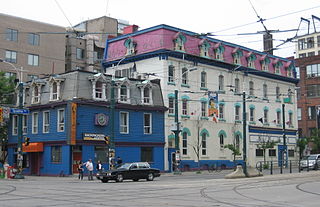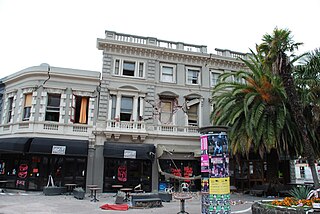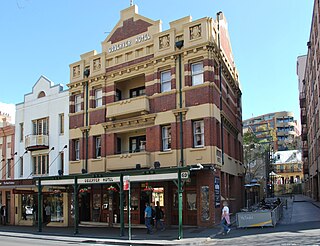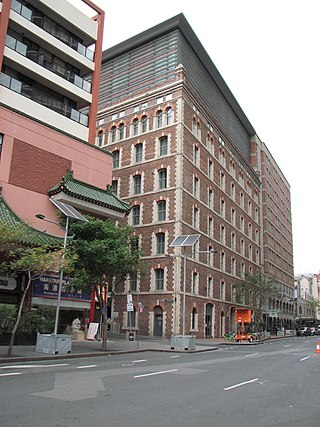
Queen Street is the major commercial thoroughfare in the Auckland CBD, Auckland, New Zealand's largest city. The northern end is at Queens Wharf on the Auckland waterfront, adjacent to the Britomart Transport Centre and the Downtown Ferry Terminal. The road is close to straight, the southern end being almost three kilometres away in a south-southwesterly direction on the Karangahape Road ridge, close to the residential suburbs in the interior of the Auckland isthmus.

Karangahape Road is one of the main streets in the central business district (CBD) of Auckland, New Zealand. The massive expansion of motorways through the nearby inner city area – and subsequent flight of residents and retail into the suburbs from the 1960s onwards – turned it from one of Auckland's premier shopping streets into a marginal area with the reputation of a red-light district. Now considered to be one of the cultural centres of Auckland, since the 1980s–1990s it has been undergoing a slow process of gentrification, and is now known for off-beat cafes and boutique shops.

Mechanics Bay is a reclaimed bay on the Waitematā Harbour in Auckland, New Zealand. It is also the name of the area of the former bay that is now mainly occupied by commercial and port facilities. Sometimes the bay formed between Tāmaki Drive and the western reclamation edge of Fergusson Container Terminal is also referred to as Mechanics Bay.

The Spadina Hotel was one of the names of the hotels operated at 460 King Street West, in Toronto, at the corner of Spadina Avenue and King Street. The hotel was built in late 1873, the three storey Victorian building featuring a small clock on the east facade. A four-storey annex was later built to the north of the hotel. It has been known by at least half dozen names, and has had many proprietors. It is now a commercial office building including a programming school.

Heritage New Zealand Pouhere Taonga is a Crown entity that advocates for the protection of ancestral sites and heritage buildings in New Zealand. It was set up through the Historic Places Act 1954 with a mission to "...promote the identification, protection, preservation and conservation of the historical and cultural heritage of New Zealand" and is an autonomous Crown entity. Its current enabling legislation is the Heritage New Zealand Pouhere Taonga Act 2014.

Princes Street is a major street in Dunedin, the second largest city in the South Island of New Zealand. It runs south-southwest for two kilometres from The Octagon in the city centre to the Oval sports ground, close to the city's Southern Cemetery. North of The Octagon, George Street continues the line of Princes Street north-northeast for two and a half kilometres. Princes Street is straight but undulating, skirting the edge of the City Rise to its northwest. The part of the street immediately below The Octagon is the steepest section, as the road traverses an old cutting through Bell Hill.

A coffee palace was an often large and elaborate residential hotel that did not serve alcohol, most of which were built in Australia in the late 19th century.

Ocean Island Inn is a historic building in Victoria, British Columbia, Canada; it is Vancouver Island's largest backpackers' inn.

The Grand Hotel, at 9 Princes Street, was the leading hotel of Auckland, New Zealand, from 1889 until 1966. With its vaulted ceilings, ornate mantelpieces, and red carpet, the Grand Hotel was a plush and social rendezvous from its opening. The Grand Hotel reopened in 1967/8 as the 'Grand Building' fitted out as offices. The leading hotels of Auckland were in the following order: The Grand Hotel, Princes St, the Central Hotel, Victoria St, the Star Hotel, Albert St, the Royal Hotel, Elliot St and the Albert Hotel, Queen St. Consequently, the Grand Hotel facade is the last surviving of the large Victorian- and Edwardian-era hotels in Auckland.

The Northern Club is a private members' club in Auckland, New Zealand. Founded in 1869, today it has more than 2,000 members, drawn from the city's professional and business community. The club's main building is designated as a Category I historic building by the New Zealand Historic Places Trust.

The Lyttelton Times Building, last known as Base Backpackers, in 56 Cathedral Square, Christchurch Central City, was the last headquarters of the Lyttelton Times before its demise in 1935 as the then-oldest newspaper in New Zealand. The building in Chicago School architectural style was registered with New Zealand Historic Places Trust as a Category I heritage item, with the registration number 7216. The building's last use was as a backpackers' hostel and a restaurant. It was demolished following the February 2011 Christchurch earthquake.

The Dux de Lux, originally called Llanmaes, was a popular beer garden and restaurant in Christchurch, New Zealand, that was part of the Arts Centre.

Clarendon Tower was a high rise building on Worcester Street at Oxford Terrace in the Christchurch Central City, New Zealand. Built on the site of the former Clarendon Hotel, the façade of the historic building was kept in the redevelopment and was protected by the New Zealand Historic Places Trust as a Category II heritage structure. Following damage from the February 2011 Christchurch earthquake, the 17-storey building has been demolished.
William Barnett Armson was an architect, surveyor, and engineer in colonial New Zealand. A co-founder of the Canterbury Association of Architects and an architect to the provincial government, he established the architectural firm Armson, Collins and Harman in 1870. It remained active until 1993 and was one of the two oldest architectural firms in New Zealand. Armson’s most important work was the Bank of New Zealand building in Dunedin.

The Excelsior Hotel in 120 Manchester Street, Christchurch, originally the Borough Hotel, in recent years known as Excelsior Backpackers or New Excelsior Backpackers, was a Category I heritage building in central Christchurch. It was designed by then most prominent architect, William Armson, and was one of the few remaining examples of his work in the city. It was heavily damaged in the February 2011 Christchurch earthquake, and all but its western façade was demolished after the earthquakes. The remaining part was demolished in April 2016.

The Russell Hotel is a heritage-listed hotel located at 143 George Street, in the inner city Sydney suburb of The Rocks, Australia. It was built in 1887. It operated as the Port Jackson Hotel until being delicensed in 1923, after which time a new Port Jackson Hotel was built further along George Street. In 1933, it became the Russell Private Hotel, providing accommodation from the upper floors. The ground floor has been leased for various uses since the original delicensing, initially as a cafe for several decades and most recently as a restaurant and bar. It is owned by Property NSW.

Observer Hotel is a heritage-listed hotel at 69 George Street, in the inner city Sydney suburb of The Rocks in the City of Sydney local government area of New South Wales, Australia. It was designed by Halligan & Wilton and built from 1908 to 1909. The property is owned by Property NSW, an agency of the Government of New South Wales. It was added to the New South Wales State Heritage Register on 10 May 2002.

The John Bridge Woolstore is a heritage-listed former warehouse located at 64 Harbour Street, in the Sydney central business district, in the City of Sydney local government area. It was probably designed by either William Pritchard or his son Arthur Pritchard, and was built by Stuart Bros. in 1889. It was added to the New South Wales State Heritage Register on 2 April 1999.

Bristol Arms Hotel is a heritage-listed pub located at 81 Sussex Street, in the Sydney central business district, in New South Wales, Australia. It is also known as the Welcome Inn Hotel. It was added to the New South Wales State Heritage Register on 2 April 1999.

Quay Street is the northernmost street in the Auckland CBD, New Zealand. The Auckland Ferry Terminal, which has ferries running to Devonport, Waiheke Island, and other places in Waitematā Harbour; the Hilton Auckland hotel; and Ports of Auckland are on the north side of the street. The Britomart Transport Centre, Queen Elizabeth Square and Grand Mercure Auckland hotel are on the south side.




















